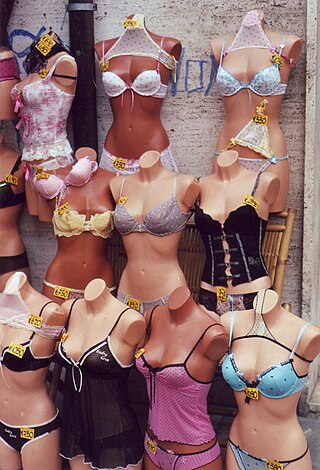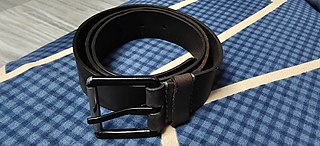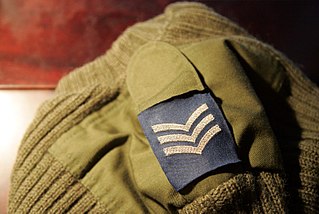
Spaghetti is a long, thin, solid, cylindrical pasta. It is a staple food of traditional Italian cuisine. Like other pasta, spaghetti is made of milled wheat, water, and sometimes enriched with vitamins and minerals. Italian spaghetti is typically made from durum-wheat semolina. Usually the pasta is white because refined flour is used, but whole wheat flour may be added. Spaghettoni is a thicker form of spaghetti, while spaghettini is a thinner form. Capellini is a very thin spaghetti, while vermicelli refers to intermediate widths, varying between the United States and Italy.

Lingerie is a category of primarily women's clothing including undergarments, sleepwear, and lightweight robes. The choice of the word is often motivated by an intention to imply that the garments are alluring, fashionable, or both. In a 2015 US survey, 75% of women reported having worn "sexy lingerie" in their lifetime.

A belt is a flexible band or strap, typically made of leather, plastic, or heavy cloth, worn around the natural waist or near it. The ends of a belt are free; and a buckle forms the belt into a loop by securing one end to another part of the belt, at or near the other end. Often, the resulting loop is smaller than the hips. Belts come in many lengths because of the variety in waist sizes, and most belts can be adjusted at the buckle to suit the wearer's waist.

A shirt is a cloth garment for the upper body.

Epaulette is a type of ornamental shoulder piece or decoration used as insignia of rank by armed forces and other organizations. Flexible metal epaulettes are referred to as shoulder scales.

The Sam Browne belt is a leather belt with a supporting strap that passes over the right shoulder, worn by military and police officers. It is named after Sir Samuel J. Browne (1824–1901), the British Indian Army general who invented it.

A dress code is a set of rules, often written, with regard to what clothing groups of people must wear. Dress codes are created out of social perceptions and norms, and vary based on purpose, circumstances, and occasions. Different societies and cultures are likely to have different dress codes, Western dress codes being a prominent example.

A strap, sometimes also called strop, is an elongated flap or ribbon, usually of leather or other flexible materials.

Morning dress, also known as formal day dress, is the formal Western dress code for day attire, consisting chiefly of, for men, a morning coat, waistcoat, and formal trousers, and an appropriate gown for women. Men may also wear a popular variant where all parts are the same colour and material, often grey and usually called "morning suit" or "morning grey" to distinguish it; considered properly appropriate only to festive functions such as summer weddings and horse races, which consequently makes it slightly less formal. The correct hat would be a formal top hat, or if on less spacious audience settings optionally a collapsible equivalent opera hat.

A slip is a woman's undergarment worn beneath a dress or skirt. A full slip hangs from the shoulders, usually by means of narrow straps, and extends from the breast to the fashionable skirt length. A half slip hangs from the waist. The word petticoat may also be used for half slips.

Halterneck is a style of women's clothing strap that runs from the front of the garment around the back of the neck, generally leaving the upper back uncovered. The name comes from livestock halters. The word "halter" derives from the Germanic words meaning "that by which anything is held". Halter is part of the German word for bra, Büstenhalter.

A foundation garment is an undergarment designed to impermanently alter the wearer's body shape, to achieve what some view as a more fashionable figure. The function of a foundation garment is not to enhance a bodily feature but to make it look more presentable.

The neckline is the top edge of a garment that surrounds the neck, especially from the front view. Neckline also refers to the overall line between all the layers of clothing and the neck and shoulders of a person, ignoring the unseen undergarments.

A shoulder mark, also called rank slide, or slip-on, is a flat cloth sleeve worn on the shoulder strap of a uniform. It may bear rank or other insignia. A shoulder mark should not be confused with a shoulder board, shoulder knot or epaulette, although these terms are often used interchangeably.

A sundress or summer dress is an informal or casual dress intended to be worn in warm weather, typically in a lightweight fabric, most commonly cotton, and usually loose-fitting. It is commonly a bodice style sleeveless dress, typically with a wide neckline and thin shoulder straps, and may be backless. A sundress is typically worn without a layering top and is not usually worn over a blouse, sweater, or t-shirt, or with leggings.

A backless dress is a style of women's clothing designed to expose the wearer's back. The back may be either partially exposed with a low cut or fully exposed with the use of strings. A backless dress is most commonly worn on formal occasions or as evening wear or as wedding dresses and can be of any length, from a miniskirt-length to floor-length. Other backless styles include backless swimsuits and tops, such as a halter top.
A top is an item of clothing that covers at least the chest, but which usually covers most of the upper human body between the neck and the waistline. The bottom of tops can be as short as mid-torso, or as long as mid-thigh. Men's tops are generally paired with pants, and women's with pants or skirts. Common types of tops are t-shirts, blouses and shirts.

Many stylistic variations of the bikini have been created. A regular bikini is a two-piece swimsuit that together covers the wearer's crotch, buttocks, and breasts. Some bikini designs cover larger portions of the wearer's body while other designs provide minimal coverage. Topless variants are still sometimes considered bikinis, although they are technically not a two-piece swimsuit.

The María Clara gown, historically known as the traje de mestiza during the Spanish colonial era, is a type of traditional dress worn by women in the Philippines. It is an aristocratic version of the baro't saya. It takes its name from María Clara, the mestiza protagonist of the novel Noli Me Tángere, penned in 1887 by Filipino nationalist José Rizal. It is traditionally made out of piña, the same material used for the barong tagalog.


















